Archer AX50 V1 User Guide
- About This Guide
- Chapter 1 Get to Know About Your Router
- Chapter 2 Connect the Hardware
- Chapter 3 Log In to Your Router
- Chapter 4 Set Up Internet Connection
- Chapter 5 TP-Link Cloud Service
- Chapter 6 Guest Network
- Chapter 7 USB Settings
- Chapter 8 HomeCare – Parental Controls, QoS, Anti-Virus
- Chapter 9 Network Security
- Chapter 10 NAT Forwarding
- Chapter 11 VPN Server
- Chapter 12 Customize Your Network Settings
-
Chapter 13 Manage the Router
- Set Up System Time
- Control LEDs
- Test the Network Connectivity
- Upgrade the Firmware
- Backup and Restore Configuration Settings
- Set the Router to Reboot Regularly
- Change the Administrator Account
- Password Recovery
- Local Management
- Remote Management
- System Log
- Monitor the Internet Traffic Statistics
- System Parameters
- Log Out
- Chapter 14 Work with Alexa
- FAQ
- Authentication
Chapter 13 Manage the Router
This chapter will show you the configuration for managing and maintaining your router.
It contains the following sections:
•Test the Network Connectivity
•Backup and Restore Configuration Settings
•Change the Administrator Account
System time is the time displayed while the router is running. The system time you configure here will be used for other time-based functions like Parental Controls. You can choose the way to obtain the system time as needed.
1.Visit http://tplinkwifi.net, and log in with your TP-Link ID or the password you set for the router.
2.Go to Advanced > System Tools > Time Settings.
Tips:
You can toggle on to enable 24-Hour Time feature before configuration, which will be applied to system-time-based functions and configurations.
•To get time from the internet:
1.In the Set Time field, select Get from the Internet.
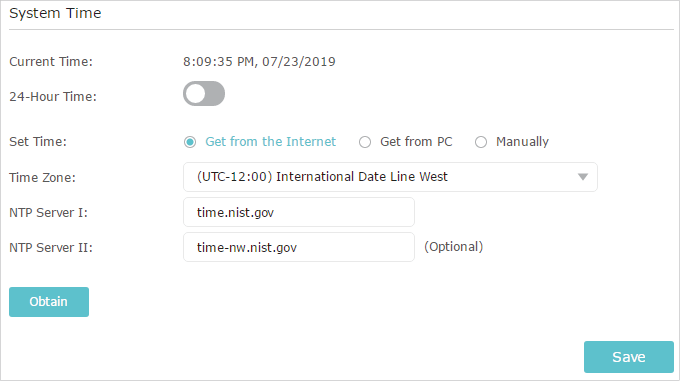
2.Select your local Time Zone from the drop-down list.
3.In the NTP Server I field, enter the IP address or domain name of your desired NTP Server.
4.(Optional) In the NTP Server II field, enter the IP address or domain name of the second NTP Server.
5.Click Obtain to get the current Internet time and click Save.
•To get time from PC:
1.In the Set Time field, select Get from PC.
2.Click Save.
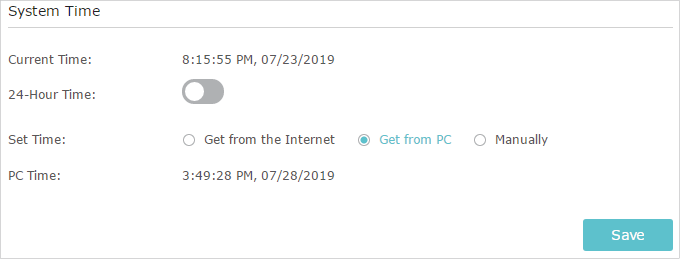
•To manually set the date and time:
1.In the Set Time field, select Manually.
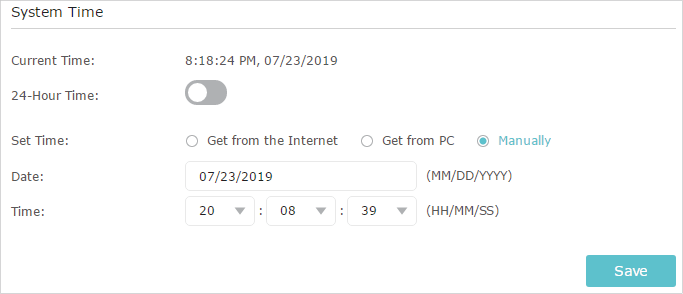
2.Set the current Date (In MM/DD/YYYY format).
3.Set the current Time (In HH/MM/SS format).
4.Click Save.
•To set up Daylight Saving Time:
1.Select Enable Daylight Saving Time.

2.Select the correct Start date and time when daylight saving time starts at your local time zone.
3.Select the correct End date and time when daylight saving time ends at your local time zone.
4.Click Save.
The router‘s LEDs indicate router’s activities and status. You can turn on or turn off the LEDs either from the web management page or by pressing the LED button.
1.Visit http://tplinkwifi.net, and log in with your TP-Link ID or the password you set for the router.
2.Go to Advanced > System Tools > LED Control.
•To control LED:
Toggle on LED Status to turn on the LED while toggle off to turn off the LED.
•To enable Night Mode:
1.Tick the Night Mode checkbox.
2.Specify a time period in the LED Off Time as needed, and the LEDs will be off during this period.
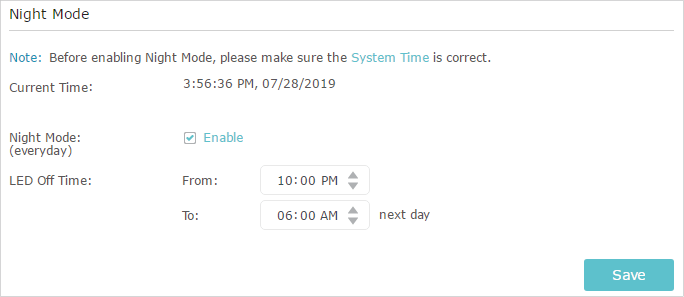
3.Click Save.
3. Test the Network Connectivity
Diagnostics is used to test the connectivity between the router and the host or other network devices.
1.Visit http://tplinkwifi.net, and log in with your TP-Link ID or the password you set for the router.
2.Go to Advanced > System Tools > Diagnostics.

3.Enter the information with the help of page tips:
1 )Choose Ping or Traceroute as the diagnostic tool to test the connectivity;
•Ping is used to test the connectivity between the router and the tested host, and measure the round-trip time.
•Traceroute is used to display the route (path) your router has passed to reach the tested host, and measure transit delays of packets across an Internet Protocol network.
2 )Enter the IP Address or Domain Name of the tested host.
4.Click Start to begin the diagnostics.
Tips:
Click Advanced, you can modify the ping count, ping packet size or the Traceroute Max TTL. It’s recommended to keep the default value.
The figure below indicates the proper connection between the router and the Yahoo server (www.Yahoo.com) tested through Ping.

The figure below indicates the proper connection between the router and the Yahoo server (www.Yahoo.com) tested through Traceroute.

TP-Link aims at providing better network experience for users.
We will inform you through the web management page if there’s any update firmware available for your router. Also, the latest firmware will be released at the TP-Link official website www.tp-link.com, and you can download it from the Support page for free.
Note:
•Make sure you remove all attached USB devices from the router before the firmware upgrade to prevent data loss.
•Backup your router configuration before firmware upgrade.
•Do NOT turn off the router during the firmware upgrade.
4.1. Online Upgrade
1.Visit http://tplinkwifi.net, and log in with your TP-Link ID or the password you set for the router.
2.When the latest firmware is available for your router, the update icon will display in the top-right corner of the page. Click the icon to go to the Firmware Upgrade page.
Alternatively, you can go to Advanced > System Tools > Firmware Upgrade, and click Check for upgrade to see whether the latest firmware is released.

3.Focus on the Online Upgrade section, and click Upgrade.

4.Wait a few minutes for the upgrade and reboot to complete.
Tips:
If there’s a new and important firmware update for your router, you will see the notification (similar as shown below) on your computer as long as a web browser is opened. Click Upgrade now, and log into the web management page with the username and password you set for the router. You will see the Firmware Upgrade page.

4.2. Manual Upgrade
1.Download the latest firmware file for the router from www.tp-link.com.
2.Visit http://tplinkwifi.net, and log in with your TP-Link ID or the password you set for the router.
3.Go to Advanced > System Tools > Firmware Upgrade.
4.Focus on the Device Information section. Make sure the downloaded firmware file is matched with the Hardware Version.
5.Focus on the Local Upgrade section. Click Browse to locate the downloaded new firmware file, and click Upgrade.
6.Wait a few minutes for the upgrade and reboot to complete.
4.3. Restore Interrupted Upgrade After Power Failure
If your router cannot start up after an upgrade interruption due to power failure, follow the steps below to restore the interrupted upgrade. Otherwise, your router cannot work again.
1.Make sure you have the latest firmware file in your computer. If not, try another way to connect your computer to the Internet and download the latest firmware file from www.tp-link.com.
2.Connect your computer to the router with an Ethernet cable.
3.Visit 192.168.0.1 and you will see the following upgrade page.

4.Click Browse and select the downloaded firmware file.
5.Click Upgrade and wait for a few minutes until the router completes the upgrading and restarts.
5. Backup and Restore Configuration Settings
The configuration settings are stored as a configuration file in the router. You can backup the configuration file to your computer for future use and restore the router to a previous settings from the backup file when needed. Moreover, if necessary you can erase the current settings and reset the router to the default factory settings.
1.Visit http://tplinkwifi.net, and log in with your TP-Link ID or the password you set for the router.
2.Go to Advanced > System Tools > Backup & Restore.
•To backup configuration settings:
Click Backup to save a copy of the current settings to your local computer. A ‘.bin’ file of the current settings will be stored to your computer.
•To restore configuration settings:
1.Click Browse to locate the backup configuration file stored on your computer, and click Restore.

2.Wait a few minutes for the restoring and rebooting.
Note: During the restoring process, do not turn off or reset the router.
•To reset the router except your login password and bound TP-Link ID:
1.Click Restore under the Factory Default Restore session.
2.Wait a few minutes for the resetting and rebooting.
Note:
•During the resetting process, do not turn off the router.
•After reset, you can still use the current login password or the TP-Link ID to log in to the web management page.
•To reset the router to factory default settings:
1.Click Factory Restore to reset the router.
2.Wait a few minutes for the resetting and rebooting.
Note:
•During the resetting process, do not turn off or reset the router.
•We strongly recommend you backup the current configuration settings before resetting the router.
6. Set the Router to Reboot Regularly
The Scheduled Reboot feature cleans the cache to enhance the running performance of the router.
1.Visit http://tplinkwifi.net, and log in with your TP-Link ID or the password you set for the router.
2.Go to Advanced > System Tools > Reboot Schedule.
3.Check the box to enable Reboot Schedule.
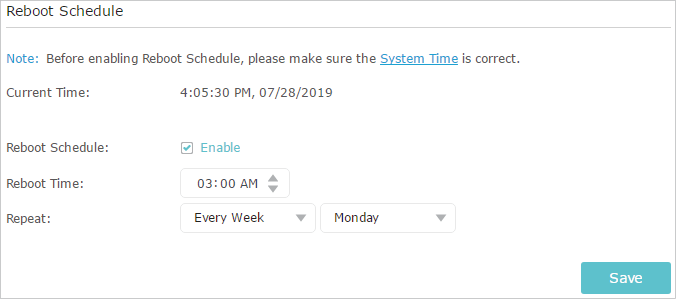
4.Specify the Reboot Time when the router reboots and Repeat to decide how often it reboots.
5.Click Save.
7. Change the Administrator Account
The account management feature allows you to change your login password of the web management page.
Note:
If you are using a TP-Link ID to log in to the web management page, the account management feature will be disabled. To manage the TP-Link ID, go to Basic > TP-Link Cloud.
1.Visit http://tplinkwifi.net, and log in with the password you set for the router.
2.Go to Advanced > System Tools > Administration and focus on the Account Management section.

3.Enter the old password, then a new password twice (both case-sensitive). Click Save.
4.Use the new password for future logins.
This feature allows you to recover the login password you set for you router in case you forget it.
Note:
If you are using a TP-Link ID to log in to the web management page, the Password Recovery feature will be disabled. To manage the TP-Link ID, go to Basic > TP-Link Cloud.
1.Visit http://tplinkwifi.net, and log in with the password you set for the router.
2.Go to Advanced > System Tools > Administration and focus on the Default Password Recovery section.
3.Tick the Enable Default Password Recovery checkbox.
4.Specify a mailbox (From) for sending the recovery letter and enter its SMTP Server address. Specify a mailbox (To) for receiving the recovery letter. If the mailbox (From) to send the recovery letter requires encryption, select Enable Authentication and enter its username and password.
Tips:
•SMTP server is available for users in most webmail systems. For example, the SMTP server address of Gmail is smtp.gmail.com. You can refer to their Help page to learn the SMTP server address.
•Generally, Enable Authentication should be selected if the login of the mailbox requires username and password.
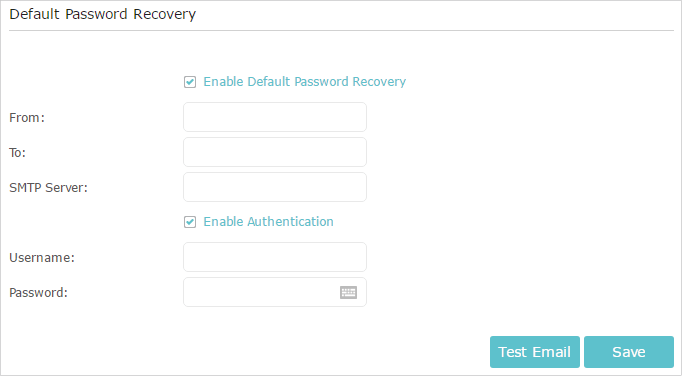
5.Click Save.
You can click Test Email to test whether the configuration is successful.
To recover the login password, please visit http://tplinkwifi.net, click Forgot Password? on the login page and follow the instructions to set a new password.
This feature allows you to limit the number of client devices on your LAN from accessing the router by using the MAC address-based authentication.
1.Visit http://tplinkwifi.net, and log in with your TP-Link ID or the password you set for the router.
2.Go to Advanced > System Tools > Administration and complete the settings In Local Management section as needed.
•Access the router via HTTPS and HTTP:
Toggle on Local Management via HTTPS to access the router via HTTPS and HTTP, or keep it disabled to access the router only via HTTP.
•Allow all LAN connected devices to manage the router:
Toggle on Access for All LAN Connected Devices.

•Allow specific devices to manage the router:
1.Toggle off Access for All LAN Connected Devices.
2.Click Add.
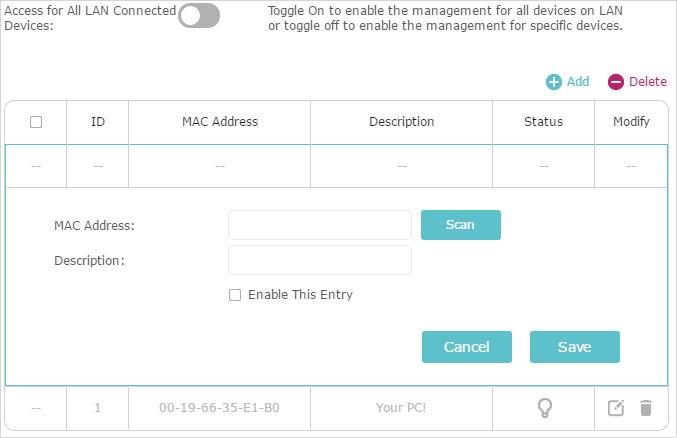
3.Click Scan and select the device to manage the router from the Existing Devices list, or enter the MAC address of the device manually.
4.Specify a Description for this entry.
5.Tick the Enable This Entry checkbox.
6.Click OK.
This feature allows you to control remote devices’ authority to manage the router.
1.Visit http://tplinkwifi.net, and log in with your TP-Link ID or the password you set for the router.
2.Go to Advanced > System Tools > Administration and complete the settings in Remote Management section as needed.
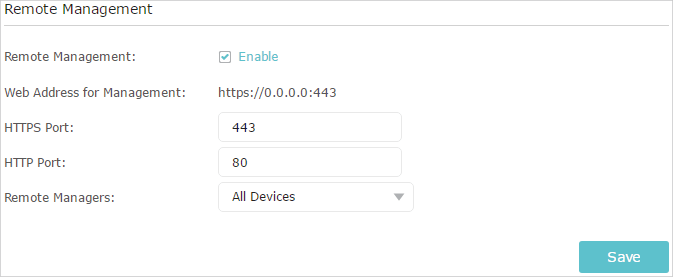
1.Tick the Enable checkbox to enable Remote Management.
2.Keep the HTTP and HTTPS port as default settings (recommended), or enter a value between 1024 and 65535.
3.Select the Remote Managers to decide which remote device can access and manage the router remotely:
•All Devices - All remote devices can access the router.
•Specified Device - Enter the IP address of the remote device to access the router.
4.Click Save.
Now you can remotely access and manage the router via the displayed Web Address for Management.
Note:
If a warning pops up when you visit the above address remotely, click Trust (or a similar option) to continue.
When the router does not work normally, you can save the system log and send it to the technical support for troubleshooting.
•To save the system log locally:
1.Visit http://tplinkwifi.net, and log in your TP-Link ID or the password you set for the router.
2.Go to Advanced > System Tools > System Log.
3.Choose the type and level of the system logs as needed.
4.Click Save Log to save the system logs to a local disk.
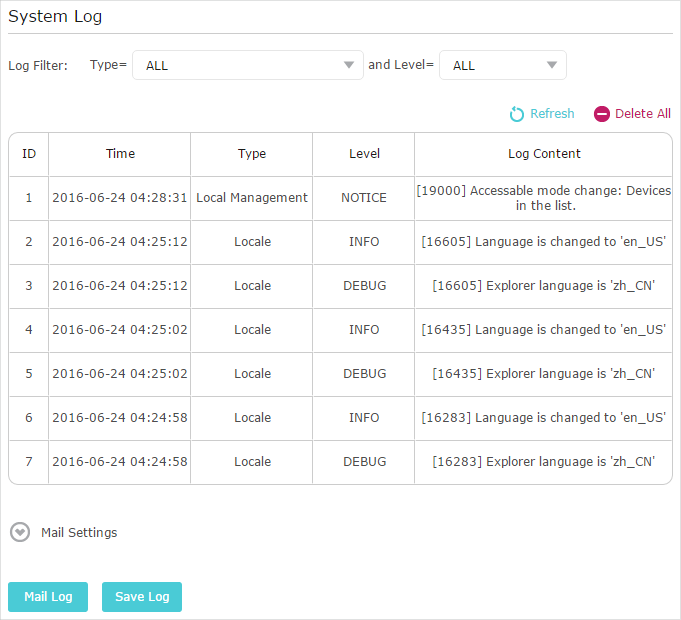
•To send the system log to a mailbox at a fixed time:
For example, I want to check my router’s working status at a fixed time every day, however, it’s too troublesome to log in to the web management page every time I want to go checking. It would be great if the system logs could be sent to my mailbox at 8 a.m. every day.
1.Visit http://tplinkwifi.net, and log in with your TP-Link ID or the password you set for the router.
2.Go to Advanced > System Tools > System Log.
3.Click Mail Settings.
4.Enter the information required:
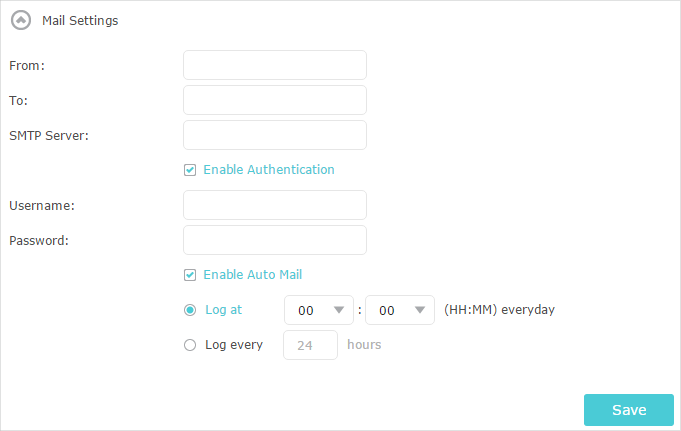
1 )From: Enter the email address used for sending the system log.
2 )To: Enter the recipient’s email address, which can be the same as or different from the sender’s email address.
3 )SMTP Server: Enter the SMTP server address.
Tips: SMTP server is available for users in most webmail systems. For example, the SMTP server address of Hotmail is smtp-mail.outlook.com. You can refer to their Help page to learn the SMTP server address.
4 )Select Enable Authentication.
Tips: Generally, Enable Authentication should be selected if the login of the mailbox requires username and password.
5 )Username: Enter the email address used for sending the system log.
6 )Password: Enter the password to login the sender’s email address.
7 )Select Enable Auto Mail.
Tips: The router will send the system log to the designated email address if this option is enabled.
8 )Set a fixed time. The recipient will receive the system log sent at this time every day.
5.Click Save.
12. Monitor the Internet Traffic Statistics
The Traffic Statistics page displays the network traffic of the LAN, WAN and WLAN sent and received packets, allowing you to monitor the volume of internet traffic statistics.
1.Visit http://tplinkwifi.net, and log in with your TP-Link ID or the password you set for the router.
2.Go to Advanced > System Tools > Traffic Monitor.
3.Toggle on Traffic Monitor, and then you can monitor the traffic usage of a specific device or all connected devices in 10 minutes, 24 hours or 7 days.
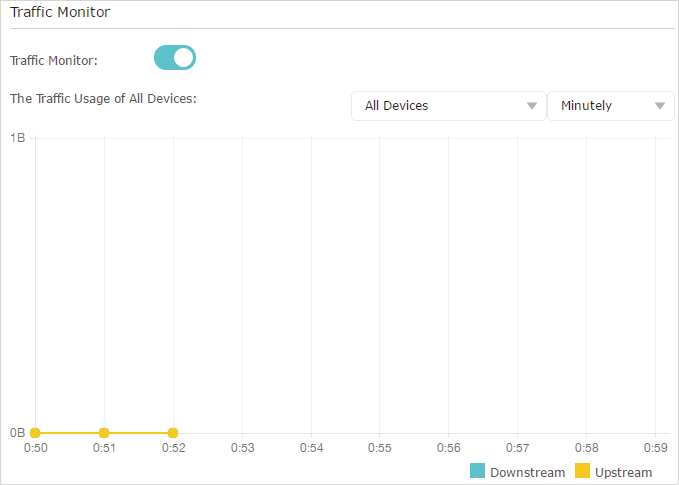
4.Check the total traffic statistics of each device on Traffic Monitor List.

Click Refresh to update the statistic information on the page.
Click Reset All to reset all statistic values in the list to zero.
13.1. 2.4GHz/5GHz Wireless
You can configure the parameters of traffic transmission rules in wireless networks. It’s recommended to keep the default settings if you are not sure of the proper ones in the case.
1.Visit http://tplinkwifi.net, and log in with your TP-Link ID or the password you set for the router.
2.Go to Advanced > System Tools > System Parameters. Focus on 2.4GHz/5GHz Wireless section.
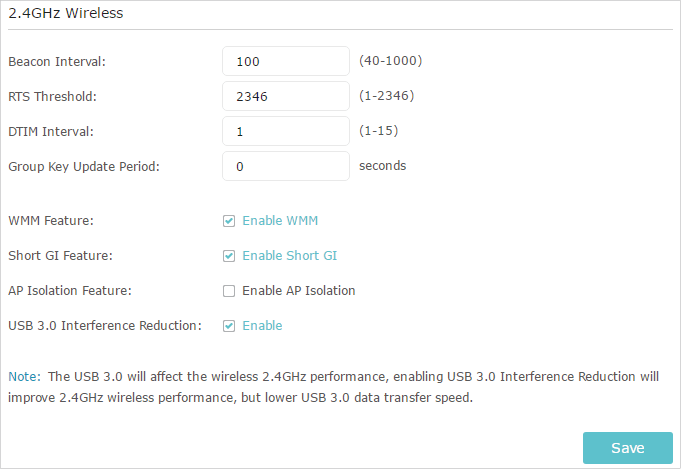
•Bacon Interval - Enter a value between 40 and 1000 to determine the duration between beacon packets that are broadcasted by the router to synchronize the wireless network. The default is 100 milliseconds.
•RTS Threshold – Enter a value between 1 and 2346 to determine the packet size of data transmission through the router. The default size is 2346. If the packet size is greater than the preset threshold, the router sends Request of Send frames to a particular receiving station and negotiates the sending of a data frame, or else the packet will be sent immediately.
•DTIM Interval - Enter a value between 1 and 15 to determine the interval of DTIM (Delivery Traffic Indication Message). The default interval is 1, indicating the DTIM interval is the same as Beacon Interval.
•Group Key Update Period - Enter the number of seconds between 30 and 86400, or use the default value 0 that indicates no key interval to control the time interval for the encryption key automatic renewal.
•WMM Feature - It is enabled by default and highly recommended, for the WMM function guarantees the packets with high-priority messages being transmitted preferentially.
•Short GI Feature - It is enabled by default and highly recommended, for it will increase the packet capacity by reducing the GI (Guard Interval) time.
•AP Isolation Feature - If you want to confine and restrict all wireless devices connected to the network from interacting with each other, but still able to access the internet, enable AP Isolation feature.
•USB 3.0 Interference Reduction - When enabled, 2.4GHz wireless performance will be improved, but USB 3.0 data transfer speed will be lowered.
13.2. NAT
The router’s NAT (Network Address Translation) feature makes devices on the LAN use the same public IP address to communicate with devices on the internet, which protects the local network by hiding IP addresses of the devices.
1.Visit http://tplinkwifi.net, and log in with your TP-Link ID or the password you set for the router.
2.Go to Advanced > System Tools > System Parameters. Focus on NAT section.
3.NAT feature is enable by default and it’s highly recommended. If you disable it, you may have no access to the internet and NAT Forwarding will not take effect.
13.3. Internet Port Negotiation Speed Setting
The router’s NAT (Network Address Translation) feature makes devices on the LAN use the same public IP address to communicate with devices on the internet, which protects the local network by hiding IP addresses of the devices.
1.Visit http://tplinkwifi.net, and log in with your TP-Link ID or the password you set for the router.
2.Go to Advanced > System Tools > System Parameters. Focus on Internet Port Negotiation Speed Setting section.

3.Select the duplex type from the drop-down list and click Save.
Click Logout at the top right corner , and you will log out of the web page and be directed to the login window.